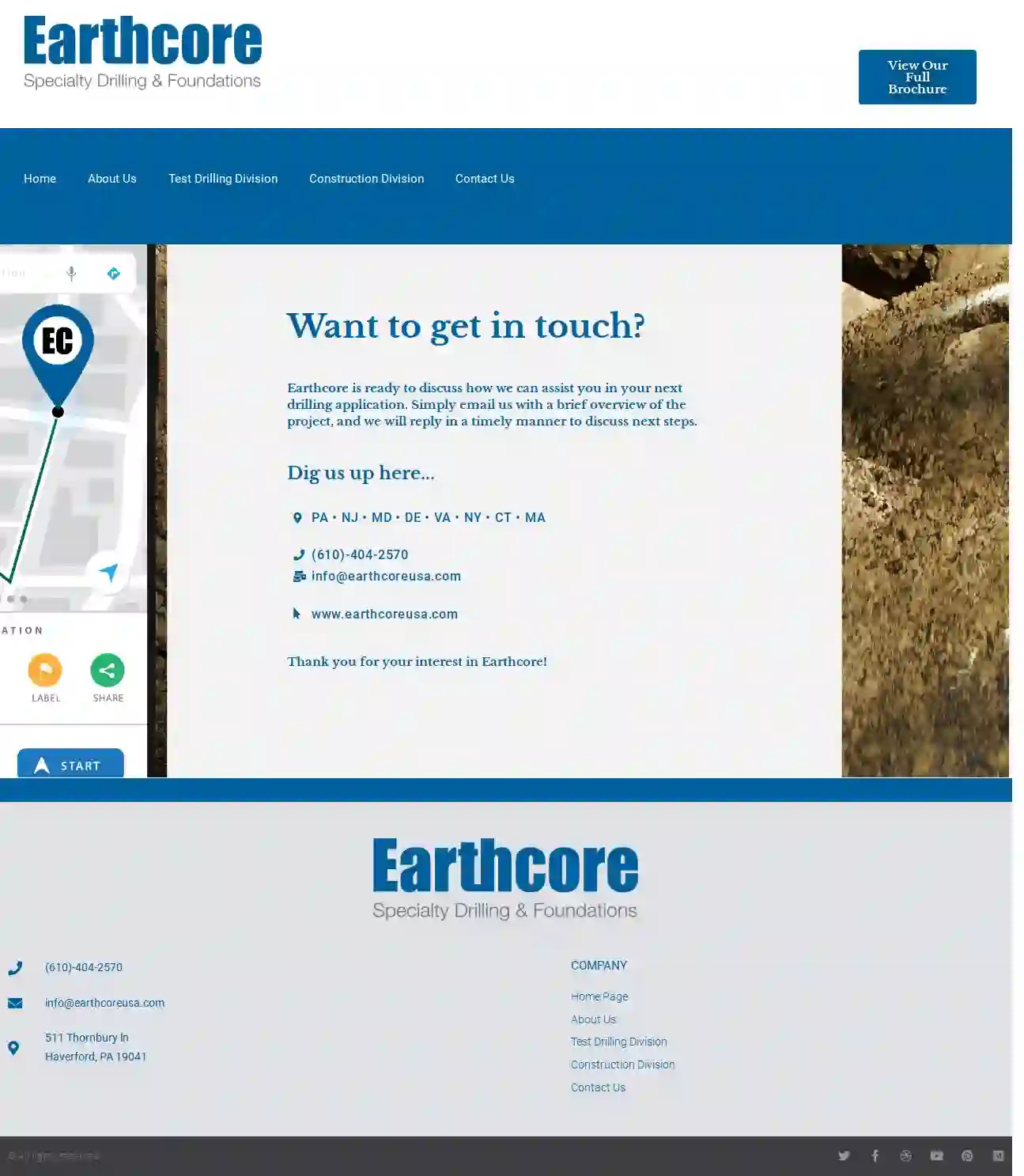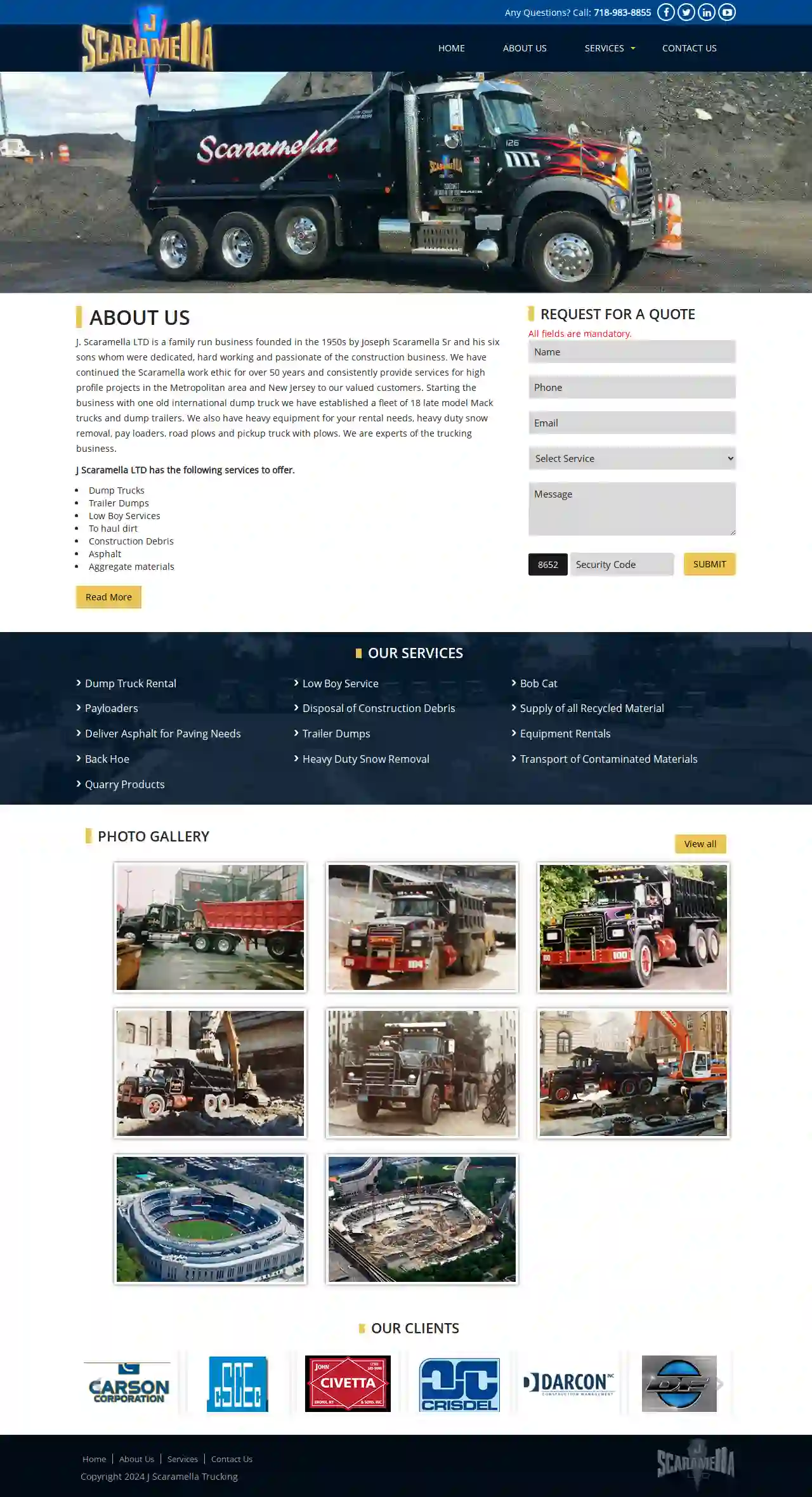Excavation Contractors Ambridge
Find top Excavation Company Near Me in Ambridge
Receive multiple Land Excavation quotes for your project today! Compare profiles, reviews, accreditations, portfolio, etc... and choose the best service.

Earthcore
11 reviews455 Fairview Chapel Road, Birdsboro, 19508, USFor decades, engineers, contractors, and property owners alike have come to rely on Earthcore as the go-to resource to resolve their toughest drilling and foundation construction challenges. Headquartered in Birdsboro, PA, we deploy our crews across the Northeast and Mid-atlantic regions. With a proven track record of documented safety, certifications, and successful execution, Earthcore brings highly-experienced operators and a large, diverse fleet of powerful rigs to job-sites rapidly to get the job done right. We invite you to do a little digging of your own to learn how Earthcore may be the perfect solution for your project. Be it test borings, soil stabilization, or assistance with specialty foundation construction, we do it all.
- Services
- Why Us?
- Gallery
Get Quote
CAG Construction Corporation
1540 Castleton Ave., Staten Island, USCAG CONSTRUCTION CORP. CONSTRUCTION DONE RIGHT Our experience ensures that your projects will be completed within budget, on time and with the upmost professionalism. LEARN MORE Family Run and Operated Construction Company Since 2007
- Services
- Why Us?
- Gallery
Get Quote
Shiloh Paving & Excavating, Inc.
3.77 reviews300 Cloverleaf Road, York, 17406, USShiloh Paving and Excavating: Your Trusted Partner for Quality Paving in York County, PA Shiloh Paving and Excavating has been serving the York County community since 1957. We are a family-owned and operated business with a commitment to providing exceptional service and exceeding customer expectations. Our team of experienced professionals is dedicated to delivering high-quality paving solutions for a wide range of projects, from residential driveways to commercial parking lots. We understand that your project is unique, and we take a personalized approach to ensure that your needs are met. We work closely with you throughout the entire process, from initial consultation to project completion, to ensure your satisfaction. At Shiloh Paving, we believe in building lasting relationships with our clients. We are committed to providing transparent pricing, timely completion, and exceptional customer service. We are proud to be a trusted partner for all your paving needs. Our Mission Statement "Whatever it Takes" We do "Whatever it Takes" through our team approach to provide excellent service and an outstanding customer experience.
- Services
- Why Us?
- Testimonials
- Gallery
Get Quote
RR Plumbing Roto-Rooter
4.8978 reviewsStaten Island, USStaten Island Plumbers Near You Plumbing & Drain Solutions: Licensed Staten Island Plumber Providing 24/7 Emergency Plumbing and Drain Services If you are currently looking for a reputable plumber in Staten Island that can meet your plumbing needs quickly and correctly the first time, then look no further. For over 85 years, RR Plumbing Roto-Rooter has been skillfully meeting the plumbing and drain cleaning needs of homes and businesses throughout the entire Staten Island, NY area. Our licensed and insured plumbers can handle commercial, residential, and emergency plumbing and drain cleaning needs of all sizes and complexities, including toilet repairs, blocked sinks, clogged shower drain repairs, sump pump replacements, and water heater installations. Our affordable plumbing services are also available 24/7 so that you do not have to wait to get the solutions you need.
- Services
- Why Us?
- Testimonials
- Gallery
Get Quote
Scaramella Trucking
3.76 reviewsYork, USAbout Us J. Scaramella LTD is a family-run business founded in the 1950s by Joseph Scaramella Sr and his six sons, who were dedicated, hard-working, and passionate about the construction business. We have continued the Scaramella work ethic for over 50 years and consistently provide services for high-profile projects in the Metropolitan area and New Jersey to our valued customers. Starting the business with one old international dump truck, we have established a fleet of 18 late-model Mack trucks and dump trailers. We also have heavy equipment for your rental needs, heavy-duty snow removal, pay loaders, road plows, and pickup trucks with plows. We are experts in the trucking business.
- Services
- Why Us?
- Gallery
Get Quote
Fischer Brothers Excavating
519 reviews712 Drinker Turnpike, Covington Twp, 18424, USWelcome to Fischer Brothers Excavating, a small company providing residential and commercial heavy equipment services to Moscow PA and surrounding areas since 2004. Robert and Jeff, both graduates of North Pocono High School, take great pride in serving their community. We are a family-owned business, and all of our work is performed by owners Robert and Jeff. We make our best efforts to answer every phone call, and most calls are returned the same day. If you have a job that requires excavation services, we will take the time to discuss your project with you to determine if we are able to help. If we are able to help, we will give you an estimated cost for your work. We offer a wide range of services, including delivery, excavating, drainage, septic systems, basement water proofing, foundation repair, utilities, grading, snow removal, and specialty services. We are licensed, certified, and insured, and we provide excavation services to areas within a 30-mile radius of Moscow, Pennsylvania.
- Services
- Why Us?
- Our Team
- Gallery
Get Quote
Diggerman Excavating
819 Lake Henry Rd., Lake Ariel, 18436, USLooking for a rock and excavation specialist? You've come to the right place! With extreme attention to detail and a passion for excavating, the Diggerman is the man you need for your project!
- Services
- Why Us?
- Gallery
Get Quote
A&J Site Contracting Corp
57 reviewsYork, USA&J - Quality, Elevation, Transformation From excavation and demolition to installation and maintenance, our skilled team is dedicated to delivering efficient and high-quality results. We pride ourselves on our commitment to customer satisfaction, transparency, and safety. With our extensive services and proven track record, we are confident in our ability to meet and exceed your expectations. Take a look around our website to learn more about our services and see why we are the go-to choice for site contracting. Let's build something amazing together. -we have 20 years of experience From groundwork to grandeur, we build your dream spaces Welcome to A&J Site Contracting Corp! We are a reliable and experienced contracting company dedicated to providing high-quality site construction services. From excavation to demolition, we offer a comprehensive range of services to meet all your site needs. Our team of experts uses the latest techniques and equipment to ensure efficient and timely completion of projects. Browse through our various sections to learn more about our services and see how we can help make your construction project a success. Trust A&J Site Contracting Corp for all your site contracting needs.
- Services
- Why Us?
- Our Team
- Gallery
Get Quote
Brubacher Excavating Inc
4.561 reviews825 Reading Road, P.O. Box 528, Bowmansville, 17507, USAt the heart of our company are hundreds of team members who apply decades of experience to deliver Insight. On Site in service our clients and communities as we live out our mission of Shaping the World We Live In. Their character, commitment, and expertise combined with our integrated services and industry-leading fleet ensure we deliver quality results from start to finish. As an excavating company who proudly serves partners across Pennsylvania, Maryland and Delaware, we provide specialized industry expertise to deliver total client satisfaction. You can count on our team to work safely and efficiently and to get the job done right on time, every time. Our Core Values At Brubacher, we honor our core values as a team in the decisions we make, results we deliver, and experiences we provide. Safety Because Life Matters Integrity Do What Is Right Initiative Make It Happen Teamwork Better Together
- Services
- Why Us?
- Gallery
Get Quote
USA Asphalt Paving Contractors
4.559 reviews3 N Line Rd, Newtown Square, 19073, USUSA Asphalt Paving Contractors: Your Trusted Paving Partner in Chester and Delaware Counties PA We understand that your driveway, parking lot, or sidewalk can be a source of frustration when they're cracked, faded, or uneven. That's why we're here to provide you with the solutions you need. We're a team of experienced paving contractors in Delaware County and Chester Counties PA, dedicated to delivering high-quality workmanship, competitive pricing, and exceptional customer satisfaction. With over 20 years of experience serving Delaware County, Chester County, Montgomery County, and beyond, we've earned a reputation for excellence. Our commitment to quality and professionalism has been recognized by leading consumer organizations. We're not just a paving contractor; we're your paving partner. We're here to help you with any paving, asphalt, or concrete services you need, making your life easier, your property safer, and your curb appeal higher. Don't settle for less. Why Choose USA Asphalt Paving Contractors? You have options, but not all paving contractors are created equal. Inexperienced contractors, unlicensed professionals, and uninsured companies can cost you time, money, and property. We understand the importance of choosing a reliable and trustworthy partner for your paving needs. At USA Asphalt Paving Contractors, we're experienced, licensed, and insured, with years of industry know-how. We're quality-oriented and competitively priced, ensuring you get the best value for your investment. We're detail-oriented experts who prioritize safety while delivering beautiful results. Don't risk your hard-earned cash on just anyone; trust the best when it comes to asphalt paving. Our Services We're your one-stop shop for all your asphalt, pavement, and concrete needs. We have the expertise and equipment to handle any size project, from small driveways to major roadways. Our comprehensive services include: Asphalt paving for driveways, parking lots, private roads, and more. We'll install, repair, or replace any asphalt surface you have, creating smooth, durable, and attractive surfaces that will last for years. Masonry and brickwork for walls, fireplaces, chimneys, and more. We can build, repair, or restore any masonry or brickwork, adding value and charm to your property. Concrete services for sidewalks, curbs, patios, and more. We'll install, repair, or replace any concrete surface, creating strong, stable, and versatile surfaces for any purpose. We can customize our services to fit your specific needs and preferences. We can also integrate certain services to create a comprehensive package for your project. We'll provide you with our honest assessment and recommendations to ensure you get the best possible results. Choose USA Asphalt Paving Contractors for guaranteed results at a price you can agree with!
- Services
- Why Us?
- Gallery
Get Quote
Over 22,076+ Excavation Contractors onboarded
Our excavation pros operate in Ambridge & beyond!
ExcavationHQ has curated and vetted Top Excavation Companies arround Ambridge. Find a trustworthy contractor today.
Frequently Asked Questions About Excavation Contractors
- Project Size and Scope: Larger, more complex excavations naturally take longer.
- Soil Conditions: Rocky or challenging soil types can slow down progress.
- Site Accessibility: Limited access might require more time for maneuvering equipment and hauling materials.
- Weather: Inclement weather can cause delays.
- Permitting and Inspections: Waiting for permits or inspections can extend the timeline.
- Project Size and Scope: The larger and more complex the excavation, the higher the cost.
- Soil Type: Different soil types require different equipment and techniques, impacting costs. Rocky or clay-rich soil can be more expensive to excavate than loose soil.
- Accessibility: Difficult-to-access sites might require specialized equipment or additional labor, increasing expenses.
- Disposal Costs: Hauling away excavated material (soil, rocks, etc.) to disposal sites incurs additional fees.
- Permits and Inspections: Depending on local regulations, permits and inspections might be required, adding to the overall cost.
- Planning and Surveying: Defining the excavation area, marking utility lines, and determining the required depth and grade.
- Site Preparation: Clearing vegetation, removing obstacles, and ensuring site accessibility.
- Excavation: Using appropriate equipment (excavators, backhoes, etc.) to remove earth and create the desired excavation.
- Hauling and Disposal: Transporting excavated material to designated disposal sites, complying with environmental regulations.
- Backfilling and Compaction: Refilling the excavation with suitable material and compacting it to achieve the required density and stability.
- Grading and Finishing: Leveling and shaping the surface to the final grade for landscaping or construction.
- New Construction: Laying foundations, basements, or underground utilities for new buildings.
- Home Additions: Creating space for new rooms, basements, or extensions.
- Landscaping: Leveling ground, creating slopes, installing retaining walls, or digging for ponds or pools.
- Drainage Improvement: Installing French drains, drainage ditches, or swales to manage water runoff.
- Utility Installation or Repair: Laying new water, sewer, gas, or electrical lines, or repairing existing ones.
- Demolition: Clearing debris and preparing the site after demolishing a structure.
How long does an excavation project take?
How much does excavation cost?
What is the excavation process?
How do I know if I need excavation for my project?
How long does an excavation project take?
- Project Size and Scope: Larger, more complex excavations naturally take longer.
- Soil Conditions: Rocky or challenging soil types can slow down progress.
- Site Accessibility: Limited access might require more time for maneuvering equipment and hauling materials.
- Weather: Inclement weather can cause delays.
- Permitting and Inspections: Waiting for permits or inspections can extend the timeline.
How much does excavation cost?
- Project Size and Scope: The larger and more complex the excavation, the higher the cost.
- Soil Type: Different soil types require different equipment and techniques, impacting costs. Rocky or clay-rich soil can be more expensive to excavate than loose soil.
- Accessibility: Difficult-to-access sites might require specialized equipment or additional labor, increasing expenses.
- Disposal Costs: Hauling away excavated material (soil, rocks, etc.) to disposal sites incurs additional fees.
- Permits and Inspections: Depending on local regulations, permits and inspections might be required, adding to the overall cost.
What is the excavation process?
- Planning and Surveying: Defining the excavation area, marking utility lines, and determining the required depth and grade.
- Site Preparation: Clearing vegetation, removing obstacles, and ensuring site accessibility.
- Excavation: Using appropriate equipment (excavators, backhoes, etc.) to remove earth and create the desired excavation.
- Hauling and Disposal: Transporting excavated material to designated disposal sites, complying with environmental regulations.
- Backfilling and Compaction: Refilling the excavation with suitable material and compacting it to achieve the required density and stability.
- Grading and Finishing: Leveling and shaping the surface to the final grade for landscaping or construction.
How do I know if I need excavation for my project?
- New Construction: Laying foundations, basements, or underground utilities for new buildings.
- Home Additions: Creating space for new rooms, basements, or extensions.
- Landscaping: Leveling ground, creating slopes, installing retaining walls, or digging for ponds or pools.
- Drainage Improvement: Installing French drains, drainage ditches, or swales to manage water runoff.
- Utility Installation or Repair: Laying new water, sewer, gas, or electrical lines, or repairing existing ones.
- Demolition: Clearing debris and preparing the site after demolishing a structure.